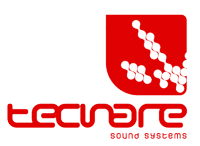Explore the World of Sound
Sound System Configuration According to Event Type
Each type of event requires a specific sound setup to ensure the best auditory experience. A live concert, a corporate conference, or a studio recording have different needs in terms of acoustics, sound pressure levels, and intelligibility.
This article explores the ideal configuration for live concerts, conferences, and recording studios, covering equipment selection, speaker distribution, alignment, and system optimization.
1. Sound System Configuration for Live Concerts
1.1. Key Features of a Concert Sound System
Concert sound systems must provide:
✅ High sound pressure level (SPL) without distortion
✅ Uniform coverage across the venue
✅ Accurate monitoring for musicians
✅ Digital system optimization
Key components include:
- Main PA: Line arrays or point source systems
- Subwoofers: Stacked or cardioid configurations
- Stage monitors: Floor wedge systems or in-ear monitors
- Delays and fills: For large-scale event coverage
1.2. Equipment Selection and Distribution
Main PA
The choice depends on event size:
- Large concerts (stadiums, festivals): Line arrays like Tecnare CLA312 or CLA21PLUS for long-distance coverage.
- Medium-sized events (theaters, auditoriums): Systems like Tecnare CLA208 or IBZA Series speakers.
Subwoofers
For powerful and controlled low frequencies, Tecnare SW218V or SW218EB (extended bass reflex design for deeper lows) are ideal.
- Cardioid configurations help prevent low-frequency buildup on stage.
Monitoring
- Floor monitors: Tecnare V14CX provides a clear and controlled response for musicians.
- In-ear monitoring (IEM): Offers higher precision for large stages.
1.3. System Optimization and Adjustments
- Alignment and prediction using EASE Focus simulation software.
- DSP processing with Tecnare DP4896 for equalization, delay, and limiters.
- Amplification using Tecnare TDAP Series digital amplifiers with built-in DSP.
2. Sound System Configuration for Conferences and Corporate Events
2.1. Key Features of a Conference Sound System
Corporate events require vocal clarity, minimal feedback, and discreet aesthetics.
🔹 Even sound distribution without dead zones.
🔹 Optimized microphones for speech intelligibility.
🔹 Digital processing for noise reduction and gain control.
2.2. Equipment Selection and Distribution
Speaker System
For large conferences, column speakers like Tecnare Tanit Series provide controlled directivity and excellent vocal clarity.
- In smaller rooms, IBZA Series speakers can be wall- or ceiling-mounted.
Microphones
- Lavalier microphones: For presenter mobility.
- Gooseneck microphones: Ideal for panel discussions.
- Handheld wireless microphones: For interactive Q&A sessions.
Processing and Optimization
- Tecnare DP4896 processor for automatic equalization and feedback suppression.
- Strategic speaker placement to avoid uneven volume levels.
3. Sound System Configuration for Recording Studios
3.1. Key Aspects of a Studio Setup
Recording studios prioritize precision and sound fidelity.
✅ Flat-response reference monitors
✅ Specialized microphones for different sources
✅ Proper acoustic isolation and treatment
3.2. Equipment Selection and Setup
Studio Monitors
- Nearfield monitoring: Tecnare IBZA 10 provides precise sound reproduction.
- Larger studios: Tecnare V14CX can be used for wider monitoring applications.
Microphones
- Large-diaphragm condenser microphones (e.g., Neumann U87, AKG C414) for vocals and acoustic instruments.
- Dynamic microphones (e.g., Shure SM57, Sennheiser MD421) for amplifiers and percussion.
Processing and Optimization
- High-resolution AD/DA conversion with premium audio interfaces.
- Acoustic correction using DSP and calibration software.
Conclusion
Each event type requires a distinct approach to sound system configuration:
🎶 Live concerts: High SPL, uniform coverage, and phase control.
🎤 Conferences: Vocal clarity, precise microphone selection, and even distribution.
🎧 Recording studios: Precision, flat response, and acoustic treatment.
Featured Articles
Explore Other Topics
Acoustic Science
Audio Technology
Sound Design
Music Production
Environmental Acoustics
Psychoacoustics
Audio Engineering
Sound History
Tecnare
Loudspeakers Series
E Series
IBZA Series
V Series
ALIS Series
Array Series
SW Series
KT Series
TANIT Series
CS Series
Amplifiers Series
Digital Processors
Accessories
